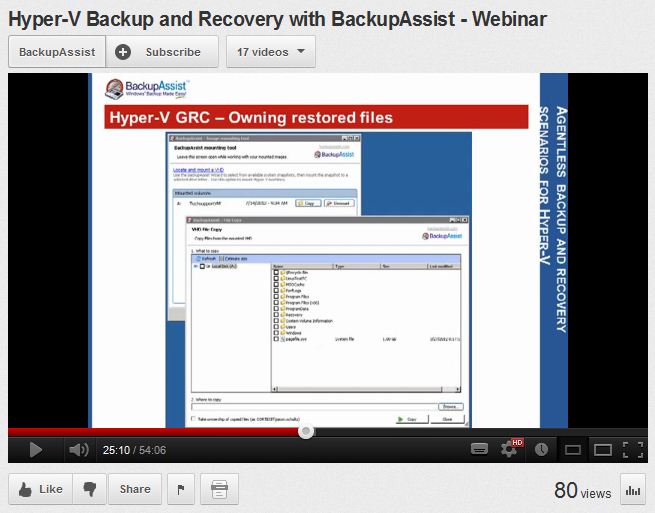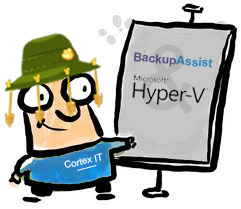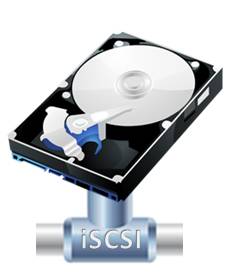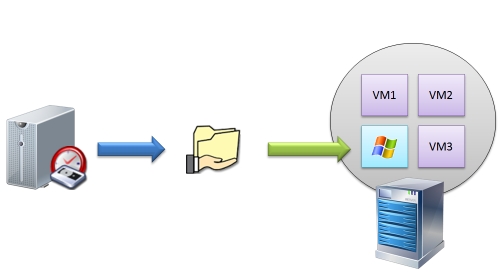21
Aug
BackupAssist’s Hyper-V backup Webinar recording now online
 A little over a month ago, I announced our friends 'down under' at BackupAssist developer Cortex IT were hosting a webinar for a limited number of channel partners from around the globe - presented by Jason Schultz, one of the lead programmers.
There were a few of you who were busy with the day jobs and weren't able to attend so the guys at Cortex have kindly uploaded the recorded version to YouTube, ready for viewing over a cuppa. Perhaps a few cuppas actually - it's a long one at a just under an hour but it really is worth sitting through if you've got any interest in using BackupAssist in a Hyper-V environment.
A little over a month ago, I announced our friends 'down under' at BackupAssist developer Cortex IT were hosting a webinar for a limited number of channel partners from around the globe - presented by Jason Schultz, one of the lead programmers.
There were a few of you who were busy with the day jobs and weren't able to attend so the guys at Cortex have kindly uploaded the recorded version to YouTube, ready for viewing over a cuppa. Perhaps a few cuppas actually - it's a long one at a just under an hour but it really is worth sitting through if you've got any interest in using BackupAssist in a Hyper-V environment.
11:58 /
BackupAssist


 Our Aussie friends over at BackupAssist developer Cortex IT, have opened up a great opportunity for our partners to attend the first in what we hope will be a series of online Webinar/ Q&A sessions.
They're presented directly by the BackupAssist development team and are a unique chance to hear about BackupAssist's Hyper-V backup capabilities while also providing feedback should you wish.
Our Aussie friends over at BackupAssist developer Cortex IT, have opened up a great opportunity for our partners to attend the first in what we hope will be a series of online Webinar/ Q&A sessions.
They're presented directly by the BackupAssist development team and are a unique chance to hear about BackupAssist's Hyper-V backup capabilities while also providing feedback should you wish.
 Last week Neil and I traded our keyboards and mice for a transit van filled with exhibition equipment, half a tonne of assorted promotional items and a rainy afternoon on the M4. Our mission, to capture the attentions of a good chunk of the 12,500 attendees to
Last week Neil and I traded our keyboards and mice for a transit van filled with exhibition equipment, half a tonne of assorted promotional items and a rainy afternoon on the M4. Our mission, to capture the attentions of a good chunk of the 12,500 attendees to  We're but a few weeks away from the annual industry pilgrimage to Earls Court for the biggest of the IT and security shows in this country,
We're but a few weeks away from the annual industry pilgrimage to Earls Court for the biggest of the IT and security shows in this country, Further to my recent
Further to my recent  You may have picked up on the grapevine (or the phone when talking to us!), that there's an exciting new version of BackupAssist in the offing.
Well, I can confirm the rumours, version 6.4 is due to include both advanced iSCSI support and RecoverAssist, which will make life considerably easier for those of you performing image backups and bare metal restores on 2008/R2/SBS/Hyper-V/Win7/Vista.
You may have picked up on the grapevine (or the phone when talking to us!), that there's an exciting new version of BackupAssist in the offing.
Well, I can confirm the rumours, version 6.4 is due to include both advanced iSCSI support and RecoverAssist, which will make life considerably easier for those of you performing image backups and bare metal restores on 2008/R2/SBS/Hyper-V/Win7/Vista.
 I often get asked about the best way to create off-site
I often get asked about the best way to create off-site We were recently asked if you could recover a Windows Image Backup of a 2008 R2 server taken with
We were recently asked if you could recover a Windows Image Backup of a 2008 R2 server taken with